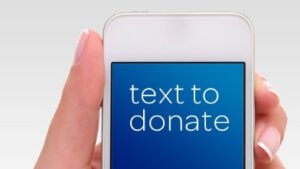Understanding SMS Donations: A Guide to Mobile Giving

In today’s digital age, the ease of mobile communication has paved the way for innovative fundraising methods. One of the most impactful among these is SMS donations. This method leverages the ubiquitous presence of mobile phones to facilitate charitable giving, making it convenient for donors and effective for organizations. Here, we’ll explore how SMS donations work and why they’ve become popular for donors and charities.
What Are SMS Donations?
SMS donations, also known as text-to-give, allow individuals to donate money to a charity by sending a text message from their mobile phone. This method is designed to be simple and accessible, enabling donors to contribute quickly without navigating through lengthy online forms or processes.
How Do SMS Donations Work?
The process of making an SMS donation typically involves the following steps:
- Keyword and Short Code: Charities partner with mobile donation service providers to set up a unique keyword and a short code. A short code is a short phone number (usually 5-6 digits) that donors can text.
- Donor Sends a Text: A potential donor sees a call to action, such as “Text HELP to 12345 to donate $10.” The donor sends the keyword (e.g., “HELP”) to the short code (e.g., “12345”).
- Confirmation and Amount: Upon sending the text, the donor receives a confirmation message. This message typically includes the donation amount and may ask the donor to confirm their intent by replying with a “YES” or another keyword.
- Billing: Once the donation is confirmed, the specified amount is added to the donor’s mobile phone bill or deducted from their prepaid balance. The mobile carrier then collects and forwards the donation to the charity, usually through a third-party aggregator.
- Acknowledgment: The charity often sends a follow-up message to thank the donor and provide a receipt or further information about the donation’s impact.
Advantages of SMS Donations
SMS donations offer several benefits that make them appealing to both donors and charities:
- Convenience: Donors can give instantly from anywhere with their mobile phone, eliminating the need for credit cards or lengthy online forms.
- Speed: The entire process takes just a few seconds, which can increase the likelihood of impulse donations during events or campaigns.
- Accessibility: SMS donations are accessible to people of all ages and tech proficiency levels, broadening the potential donor base.
- Engagement: Charities can use follow-up texts to engage donors, provide updates, and encourage further involvement.
Considerations for Charities
While SMS donations are advantageous, there are some considerations for charities to keep in mind:
- Costs and Fees: Mobile carriers and third-party service providers may charge fees for processing SMS donations. Charities should understand these costs and how they impact the net amount received.
- Donation Limits: SMS donations often have lower transaction limits (e.g., $5-$10 per donation), which may not be suitable for all fundraising goals.
- Compliance and Security: Charities must ensure compliance with regulations governing mobile donations and protect donors’ personal information.
Conclusion
SMS donations represent a powerful tool in the modern fundraising arsenal, combining convenience, speed, and accessibility to engage donors and raise funds effectively. By understanding how SMS donations work and leveraging best practices, charities can harness the full potential of mobile giving to support their missions and make a difference in the world.
